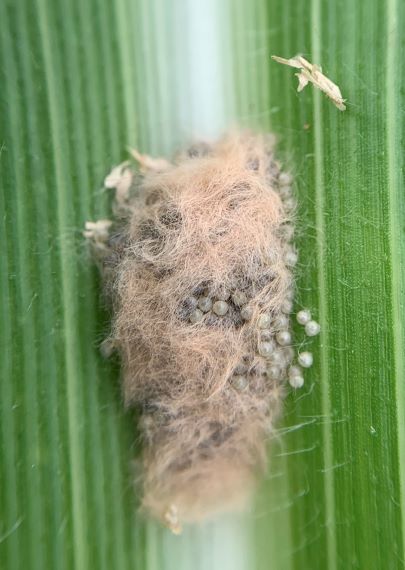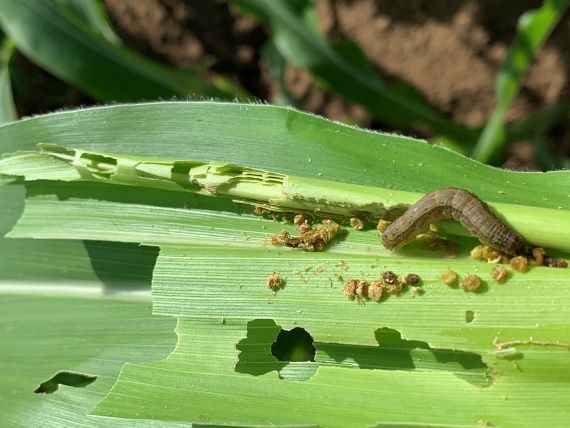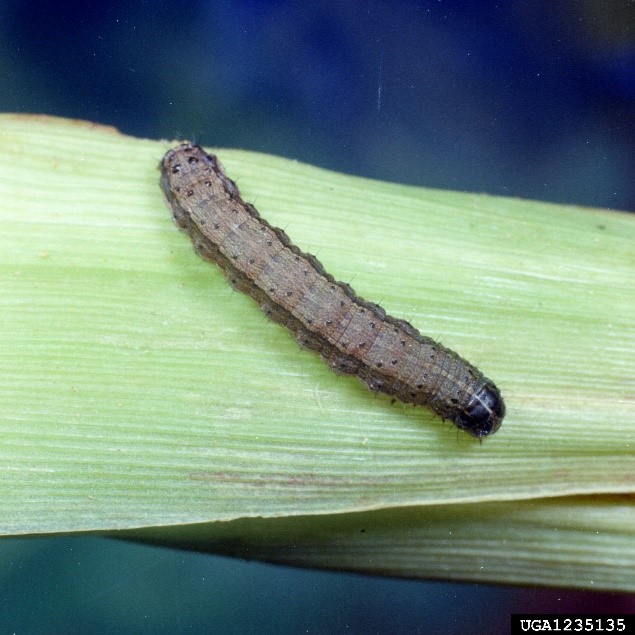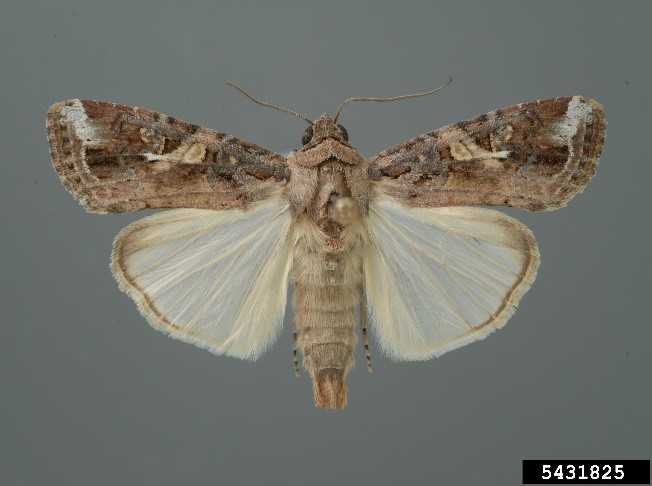
Fall armyworm
| Primefact number | Edition | Published | Author |
|---|---|---|---|
| 1722 | Second | Oct 2020 | Plant Biosecurity and Product Integrity |




Fall armyworm (Spodoptera frugiperda) is an insect pest that was first detected in NSW in September 2020. It is considered established in NSW.
This insect pest is a serious threat to a wide range of industries including grain, rice, cotton, vegetables and sugarcane.
Description
Fall armyworm is the name commonly attributed to the larval stage of the moth Spodoptera frugiperda. Other Spodoptera species already found in Australia include the lawn armyworm and the dayfeeding armyworm.
The fall armyworm life cycle has an egg stage, 5 to 6 caterpillar (larval) stages, a pupal stage and an adult moth stage. The larval life cycle stages cause widespread damage to crops through feeding.
Fall armyworm eggs are usually laid on the under surface of leaves in clustered masses of 100-200, covered with a ‘felt like’ layer of scales (Figure 1). The eggs are pale yellow.
Small fall armyworm larvae are usually light green to brown, with a dark head capsule. Young larvae feed on one surface of the leaf. What remains is an opaque layer of cuticle referred to as a ‘window’ which are typically more evident than the presence of larvae (Figure 2).
Large fall armyworm larvae grow to 3-4 cm, becoming darker as they mature, with pale white stripes along the length of the body (Figure 3). The large caterpillars have a pale inverted “Y” shape between the eyes. Two dark spots with dark spines occur on each body segment on the upper body surface, with 4 black spots arranged in a square on the last abdominal segment.
Fall armyworm larvae normally pupate in the soil. The pupae are shiny brown and between 1.3 and 1.7 cm long.
Adult fall armyworm moths measure 3-4 cm from wingtip to wingtip. Female moths are slightly larger than males, although both sexes have a white hindwing with a dark-brown margin. Male moths are more patterned and have distinct triangular white spots at the tip and near the centre of each forewing (Figure 4).
Damage
Fall armyworm damage by larger larvae in many crops produces similar symptoms on foliage to that caused by other caterpillars and chewing insects. If you find crop damage symptoms, carefully examine the plants for larvae to identify which species are present.
Life cycle
Fall armyworm can complete its life cycle within 23-27 days (from egg laying to the emergence of adult moths), when suitable temperatures and host plants are present.
The eggs hatch within 2-4 days after being laid on the lower leaf surfaces. After hatching, fall armyworm larvae complete 5 to 6 growth stages within 14-22 days of hatching to reach maturity. Once mature, larvae drop to the ground, where they pupate for around 8-9 days in warmer months and 20-30 days in cooler areas.
Female moths lay most of their eggs within 4-5 days of mating but can continue laying for up to 2 weeks. As fall armyworm does not diapause (suspend development) during the pupal stage, populations are unlikely to establish in areas where temperatures fall below 9-12⁰C and where frosts occur.
Host range
Fall armyworm larvae feed on more than 350 plant species, with a preference for grasses. Key hosts include cotton, maize, rice, sorghum, sugarcane, wheat and vegetable crops like sweet corn.
Spread
Adult fall armyworm moths are strong flyers and will travel hundreds of kilometres on storm fronts. The larvae can also be spread in cut flower, fruit and vegetable consignments.
Distribution
Fall armyworm is native to the tropical and sub-tropical regions of the Americas. In early 2016 it was detected in Central and Western Africa and quickly spread across sub-Saharan Africa. By December 2018, it was found in the Indian subcontinent. In June 2019 fall armyworm was reported in China and Southeast Asia.
Fall armyworm was confirmed as present in Australia in 2020 and is now considered established.
Management tips
Know if the pest is in your area
Moth surveillance is an important first action in management because it alerts growers the presence of local fall armyworm activity.
Follow up with regular in-crop monitoring for larvae and signs of damage
If in doubt about which species of larvae is in your crop, send clear images of the head and tail to: fallarmyworm@dpi.nsw.gov.au
Optimise control costs by timely application of selective insecticides on above threshold populations
If sprays are warranted, act fast with full-rates of insecticide to target small larvae before they establish in whorls of plants, at which point control will be more difficult to achieve.
Approach control with an IPM focus and take advantage of natural enemies present in crops
Make spray decisions that will conserve beneficial insects which help suppress FAW populations in your crop. Consider biological options such as Bt and virus products as part of an IPM strategy.
Know which chemicals are likely to be MOST effective on FAW
Selective insecticides such spinosyns (Group 5, e.g. Entrust®, SuccessNeo®), emamectin benzoate (Group 6, e.g. Affirm®, Proclaim®) and chlorantraniliprole (Group 28, e.g. Altacor®, Coragen®) are likely to provide effective control if used correctly.
Know which chemicals are NOT effective on FAW
FAW has high levels of resistance to synthetic pyrethroids such as alpha-cypermethrin and growers are advised to avoid these products because they will not control of FAW and they will destroy crop beneficials.
Be mindful of the effect your insecticide sprays could be having on other pests in the crop
Overuse of selective insecticides will increase resistance levels in FAW and Helicoverpa armigera. Use a planned approach to insecticide selection and chemical rotation in maize and sorghum to minimise resistance risk.
Actions to minimise risks
Put in place biosecurity best practice actions to prevent the entry, establishment and spread of pests and diseases:
- practice “Come clean, Go clean”
- control weeds and volunteer plants in fallow paddocks, along fence lines and around buildings to reduce the number of pest hosts
- monitor crops regularly for signs of armyworm damage
- keep records
Resources
- Chemical management options
- Poster: Fall armyworm (PDF, 1446.53 KB)
- Queensland government information on fall armyworm
- The Beatsheet - Fall armyworm information and video
- The Beatsheet - Fall armyworm, should you be concerned?
- The Beatsheet - Fall armyworm trapping for QLD and NSW
- Australian government information on fall armyworm
- CottonInfo fall armyworm identification guide (PDF, 652KB)
- Croplife Australia Resistance Management strategy
- GRDC Fall armyworm portal
- Fall Armyworm Continuity Plan for the Australian Grains Industry

